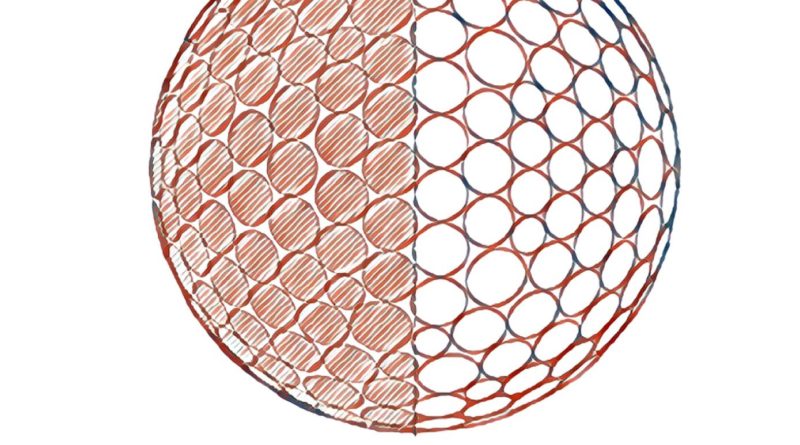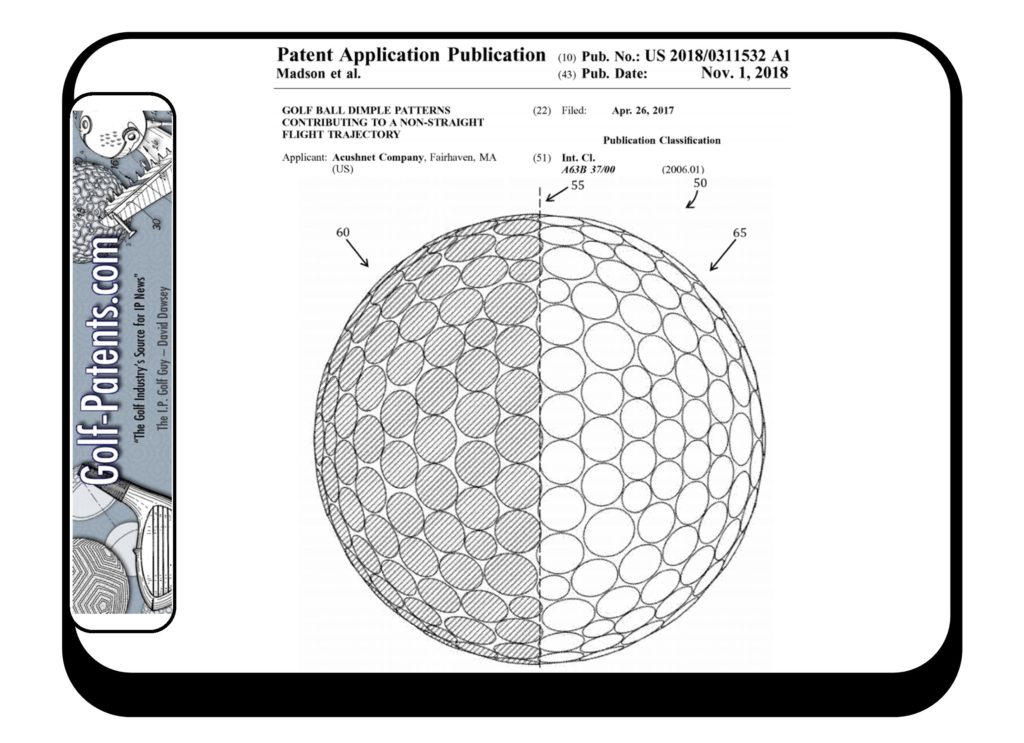Do Any of the Major Golf Equipment Companies Have the Balls to Enter the Non-Conforming Equipment Market?
Will the Major Golf OEM’s Enter the Non-Conforming Equipment Market?
Patents applications directed to clearly non-conforming golf equipment are not that rare. It is however rare to see such an application associated to one of the major golf equipment companies, which is why a recently published patent application caught my eye.
The application published as US Pub. No. 20180311532 titled “Golf Ball Dimple Patterns Contributing to a Non-Straight Flight Trajectory,” which describes the invention as:
The present invention provides golf balls having a non-straight flight trajectory due, at least in part, to a dimple pattern wherein the dimples on the opposing sides of the ball have at least one design feature that is different.
The application goes on to explain:
BACKGROUND OF THE INVENTION
[0002] Golf balls must meet certain standards in order to be included on the official Conforming Golf Balls List (the “List”) produced by the United States Golf Association and The Royal and Ancient Golf Club of St. Andrews, Scotland, the two ruling bodies for the game of golf. Inclusion on the List is a requirement for use in competitive golf, and most serious players, including recreational golfers, won’t use a ball unless it appears on the List.
[0003] One of the standards, commonly referred to as the “Symmetry Rule,” specifies that a ball must fly essentially the same distance and for essentially the same amount of time regardless of how it is oriented when struck by the golf club. Thus, golf ball manufacturers generally pursue dimple patterns that provide a ball with symmetrical aerodynamic properties regardless of orientation. In dimple patterns resulting in conforming aerodynamic properties, the dimples on one side of the mold parting line typically have the same design features (i.e., dimple diameter, plan shape, profile shape, edge angle, placement of the dimple within the overall pattern, etc.) as the dimples on the other side of the mold parting line. However, dimple patterns resulting in conforming aerodynamic properties have also been disclosed wherein at least some of the dimples on one side of the mold parting line have a different design feature than those on the other side of the mold parting line. For example, U.S. patent application Ser. No. 14/985,743 to Madson, et al., filed on Dec. 31, 2015, discloses dimple patterns that achieve flight symmetry despite the use of different dimple geometries on the opposing hemispheres due to equivalent dimple volume ratio between opposing hemispheres.
[0004] In spite of the Symmetry Rule, golf balls having non-conforming aerodynamic properties have been disclosed and are commercially available. The primary objective of such balls is typically to reduce the effect of hits by unskilled golfers (e.g., hooks and slices) in order for the ball to fly more consistently along a straighter path. For example, the Polara ball, further described in U.S. Pat. No. 3,819,190 to Nepela et al., is a non-conforming ball that allegedly corrects any natural slice or hook through the use of enlarged, shallower dimples along the y-axis and smaller, deeper dimples along the x-axis. Golf balls having non-conforming aerodynamic properties have also been disclosed, for example, in U.S. Patent Application Publication No. 2013/0090189 to Felker et al., which is directed to a non-conforming golf ball having a dimple pattern which causes the ball to have a preferred spin axis because of the weight differences caused by locating different volume dimples in different areas across the ball. This, in turn, allegedly reduces the tendency for the ball to hook or slice during flight.
[0005] In contrast to the above golf balls, an object of the present invention is to provide a golf ball with a non-straight flight trajectory when the ball is hit in a particular orientation with respect to the dimple pattern. The non-straight flight trajectory is, at least in part, the result of a novel dimple pattern wherein the dimples on the outer surface of one side of the ball have at least one design feature that is different from the dimples on the outer surface of the other side of the ball.
SUMMARY OF THE INVENTION
[0006] The present invention is directed to a golf ball having a plurality of dimples on the outer surface thereof. The outer surface can be divided by a dividing plane that passes through the geometric center of the golf ball and divides the outer surface into a first side and a second side. The ball has a non-straight flight trajectory as shown by an absolute transverse coefficient of greater than 0.013 at a Reynolds Number of 226300 and a spin ratio of 0.124, an absolute transverse coefficient of greater than 0.023 at a Reynolds Number of 143500 and a spin ratio of 0.151, and an absolute transverse coefficient of greater than 0.043 at a Reynolds Number of 74500 and a spin ratio of 0.207, when oriented such that the ball axis of rotation is normal to the dividing plane. In one embodiment, a majority of the dimples on the first side are spherical dimples, a majority of the dimples on the second side are spherical dimples, and the average edge angle of the spherical dimples on the first side is at least 1.degree. greater than the average edge angle of the spherical dimples on the second side. In another embodiment, the difference between the average dimple volume of the dimples of the first side (DV.sub.S1) and the average dimple volume of the dimples of the second side (DV.sub.S2) is greater than 7.30.times.10.sup.-6 in.sup.3. In another embodiment, the dimple arrangement on the first side is different from the dimple arrangement on the second side.
Take a guess which golf company filed this non-conforming golf ball patent application. (Let me know in the comments).
Interestingly, things are not going well for the application, as it has received a final rejection from the patent office and all of the proposed claims are rejected.
I have never tried non-conforming balls, but given the state of my game it may be time. Frankly, I was surprised by the variety of non-conforming golf balls on the market.
So, is 2019 the year that we see a major equipment company enter the non-conforming market? My guess is… nope, but I would be impressed if any of them have the balls to do it. I believe the market is ready for a mainstream non-conforming golf ball, and even if the 5 year penetration is only 5-10% of the golf ball market – that is a lot of money.
Dave Dawsey – The Golf Invention Lawyer
PS – please follow me on Twitter (@GolfPatents), and heck – connect with me on LinkedIn.
PPS – If you like what we are doing, please considering helping us out and make your online gear purchases through our Amazon affiliate link. Every little purchase helps us keep the site up and running! Thanks.


